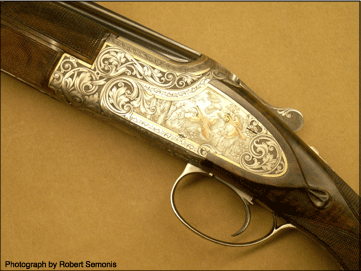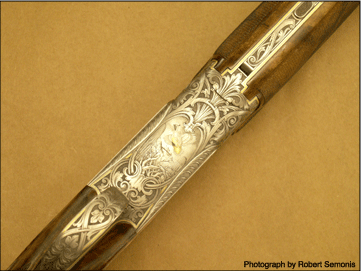The Secret of the Browning Superposed
The shotgun stood upright in a museum-quality case, halogen lamps kindling the mystique of the Prodigal Son.
The Browning Superposed in front of us was a one-of-a-kind called Golden Days. Belgian master engraver Dany Matagne had spent 300 painstaking hours detailing the doves, bobwhite quail and Gamble quail with gold, green gold, copper and palladium – the entire landscape study framed in a floral scroll. If ever there was a rendition of upland heaven, it was here on the receiver of this $80,000 Superposed.
A man stood next to me reading the modest placard on the case. He clasped two gaudy plastic bags jammed with brochures and give-aways. We were attending the recent Shot Show, and found ourselves in the Browning area. Despite the hubbub of tens of thousands of industry movers and shakers scrambling for the next big deal, the Superposed exuded a quiet dignity. It did not have to prove itself in the hoopla and hype. It was only meant for discerning eyes appreciative of its place in history.
The man turned to me. “I didn’t know they made these anymore.”
Most shotgun enthusiasts would have agreed with him. But a handful of privileged owners know that you can still order a marvelous Superposed built exactly to your specifications from the Browning Custom Shop in Liege, Belgium – and the Golden Days is solid proof.
The Golden Days Superposed was certainly a play on words. In addition to the precious metals, it harked back to the Superposed as the first over-under shotgun manufactured and the very last firearm designed by John Browning. The Superposed served as the cornerstone for Browning’s ultimate reputation for affordable, reliable and quality shotguns – while claiming for itself a chapter in the annals of shotgun history.

As it turns out, the Superposed nearly didn’t make it off the drawing board. John Browning started sketching the design in 1922. Unfortunately, he died in1926 before plans of his boxlock over/under could be completed.
His son, Val Allen Browning, took up the flag. He completed the design’s details. However, after being rejected by several American manufacturers, he granted production rights under a royalty agreement under his patents in 1931 to the Belgian manufacturer, Fabrique Nationale. Yet, John Browning’s moniker for the shotgun stuck: the notion of superimposing one barrel over the other was streamlined to Superposed.
Not long after the deal was sealed with Fabrique Nationale, the first shipment of Superposed arrived in the U.S. – introducing American sportsmen to innovations such as the selective trigger, automatic ejectors and the ventilated rib.
From 1931 to 1948, the Superposed was only available as a 12 gauge. The first 20-gauge Superposed was manufactured in 1949. In 1962, Browning rounded out the Superposed family with 28 gauge and .410 models. Tally them all up, and some quarter-million Superposed were produced during more than half a century.
Despite the enormous volume of shotguns made, the Superposed achieved the reputation of a singular American legend. The Superposed was prized for its iron durability, forthright masculinity and lasting impression on the world of shotguns.
Since John Browning intended the Superposed as an affordable “everyman’s” shotgun, it cast a wide net among sportsmen. The glowing reputation of the Superposed rapidly spread long before the Internet and cell phones.
The Browning Superposed became known as an icon of American moxie. It survived the Great Depression, World War II and the Army-McCarthy Hearings. As America’s cities burned during the mutinous 1970s, the Superposed stood fast as a symbol of sovereignty and resilience.
Securing its place in history, the basic Superposed design remained virtually unchanged, prevailing over successive autoloaders, synthetic stocks and release triggers. And why not? In many influential circles, the Superposed had become recognized as the most reliable shotgun ever made.

But in the 1960s, it was the economy, not the shotgun community that started to turn against the Superposed. At Fabriqune National in Belgium, the rising cost of labor presented an ever-challenging business case for the ongoing assembly of the Superposed.
This was also the time that Browning was starting to place emphasis on its next-generation shotgun called the Citori.
Finally, in 1977, the Superposed Grade I, the Pigeon, the artfully engraved and pricy Diana, and the gold-inlaid Midas were all removed from the standard Browning catalog and price list. However, the company stated that it would build a Superposed by customer request.
It was easy to understand why most people believed the celebrated Superposed was simply no more. Over the ensuing decade, the inventories were depleted. The second-hand market for the Superposed remained thin. Owners held fast to their beloved shotguns, accepting as true that the best shotgun in America would never roll out of the factory again.
Apparently, they underestimated Browning…
During the 1980s, special-edition Superposed shotguns began trickling into the market. There was the Waterfowl Superposed, (Mallard Issue) of 1980; a Waterfowl Superposed (Pintail issue) in 1982; and a Diana, Midas Superposed in 1985; and the European B-25 Superposed in 1988.
While Americans clung to the belief that Browning had suspended production of the Superposed, European shooters, and particularly Belgians, knew better. In the 1990s, they were buying a shotgun called the B25, which in fact was the Superposed with a European nomenclature. At the time, production amounted to a miniscule 10 guns per year.
Fast forward 14 years and in 2002, Browning president and CEO Charles Guevremont tasked company veteran Ron McGhie with selling more of Fabriqune National’s Custom Shop guns in the U.S.
And since the Custom Shop is home of the Browning Superposed, we can expect to see more American owners in the coming years.
Although the Superposed of today has a list of standard specifications, customers can special order one to their exact specifications, including a 16-gauge version.
McGhie is careful to characterize the current Superposed program in the U.S. as a resurrection. Instead, he says “we’re just trying to make the Superposed visible again in America.”
Still, McGhie freely admits that ongoing production of the Superposed may be one of the best-kept secrets in the shotgun universe, with an output of 116 shotguns in 2008 and approximately 250 made in 2007. Even now, there is a two-year waiting list for an American icon that has barely changed since its 1931 unveiling.
Irwin Greenstein is Publisher of Shotgun Life. Please send your comments to letters@shotgunlife.com.
Useful resources:
To find the Authorized Browning Superposed dealer near you, please click on this link:
http://www.browning.com/products/catalog/firearms/custom/dealers.asp
The definitive book on the Browning Superposed is available at Amazon.com:
Browning Superposed: John M. Browning’s Last Legacy (Hardcover)

Irwin Greenstein is Publisher of Shotgun Life. Please send your comments to letters@shotgunlife.com.


Comments